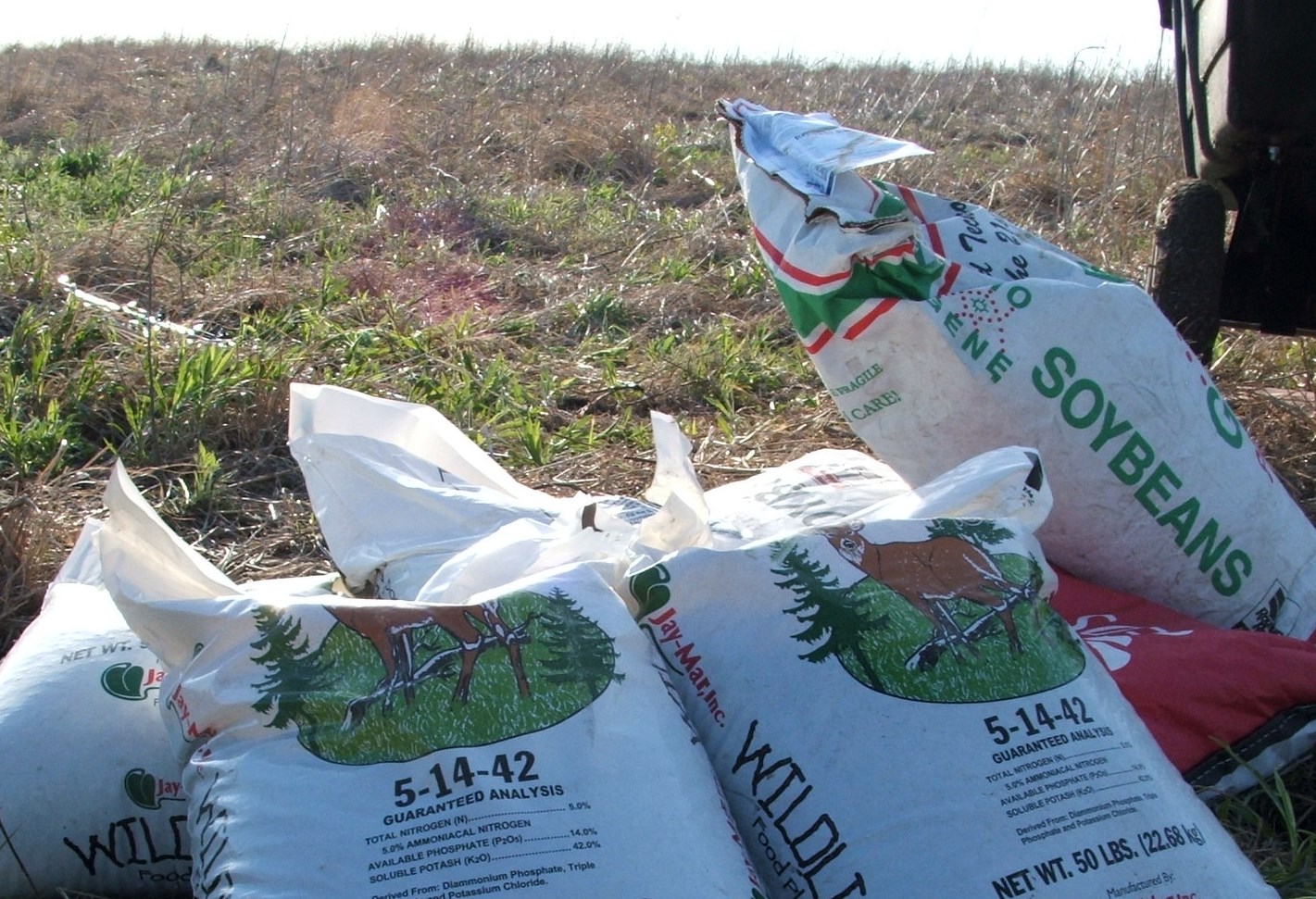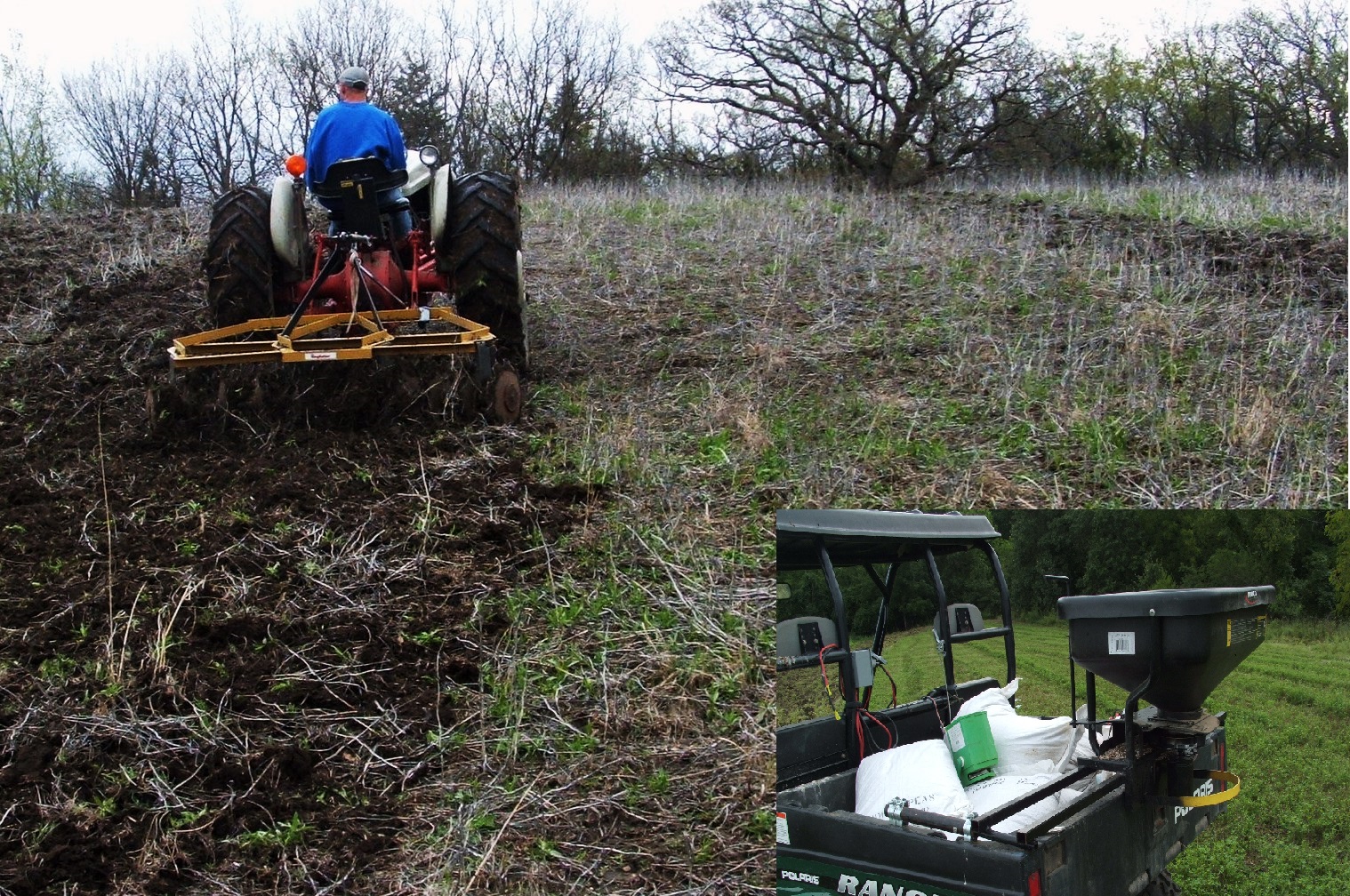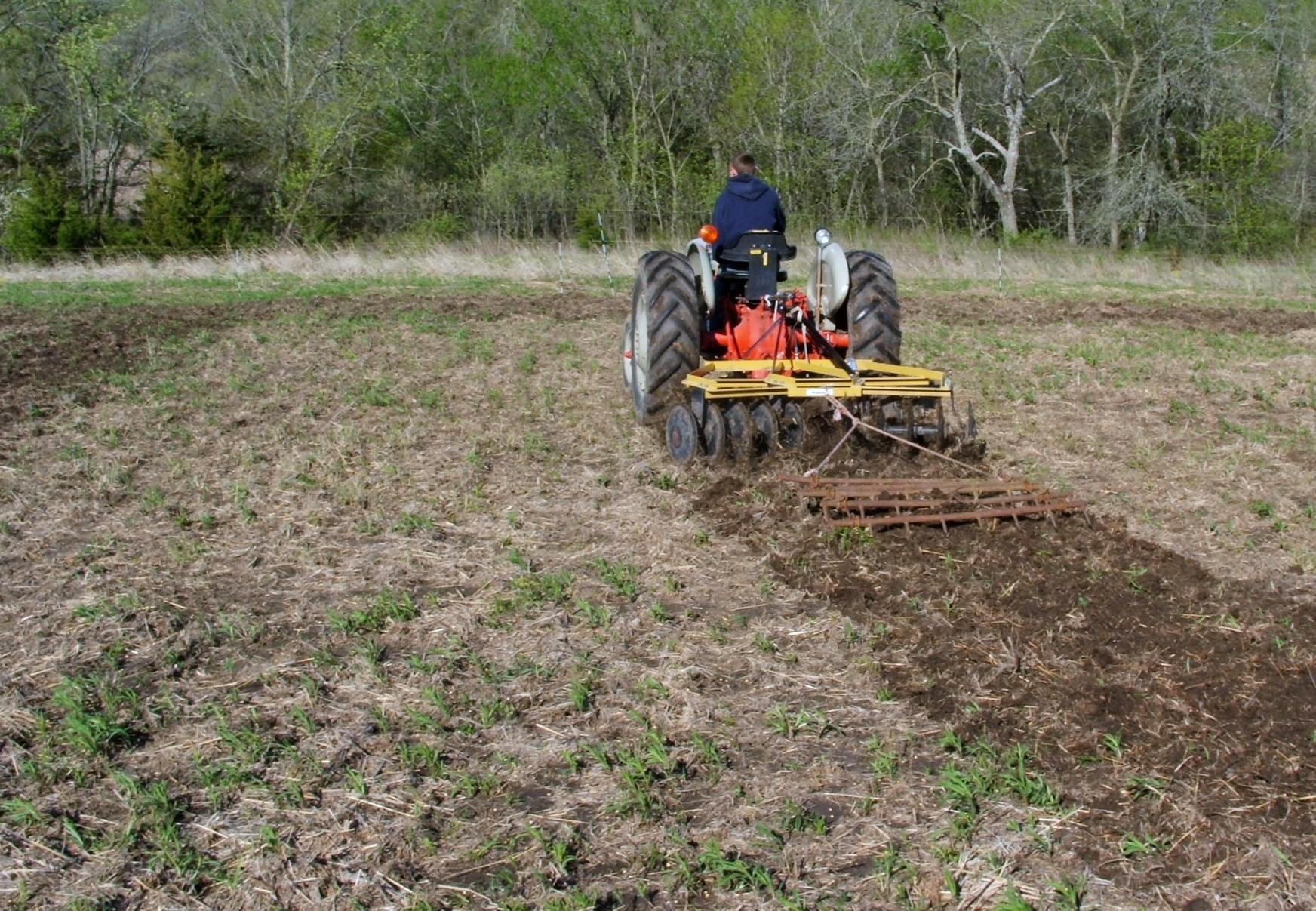May 2015-Spring Planting Food Plots
Introduction–In January’s issue of Whitetail 365, I laid out equipment and associated costs for that equipment in planning out the year’s habitat improvements. To make at least a dent in improving the habitat on your hunting grounds you need at least some basic equipment. That issue covered how a tractor and disc along with a seeder of some sort would get you well on the way to planting food plots successfully. In this issue, I’m going to cover how to plant any food plot using just those pieces of equipment. I guess an argument could be made that the planting methods and techniques I’m going to cover are sub-ideal, but for the hunter on a time and money budget, the methods I’m going to cover are above adequate. Putting in food plots doesn’t have to be hard or complicated.
Planting Depths-When determining how deep to plant a seed, the size of the seed is what you pay attention to. The larger the seed the deeper it can be planted (and in most cases should be planted). Smaller seed then is planted shallower and so on. This is because a seed contains all the nutrients a plant needs until it reaches the surface—makes contact with the sun—and begins photosynthesis—thereby making its own food. If a small seed is planted too deep it will run out of energy before reaching the surface and making contact with the sun. Larger seeds like corn or soybeans can be planted deeper because there is more energy (food) available from the seed itself. Unless you have a precision planter, seed depth will be at least somewhat difficult to control. But, don’t worry…you don’t need a planter to pull this off. I’ve created a table for you with seed planting depth for common food plot varieties.
| Very Small Seed (clover, alfalfa, brassicas, grasses) | 1/4 to 1/2 inch deep |
| Small Seed (radish, oats, peas, sunflower) | 1/2 to 1 inch deep |
| Medium Seed (winter rye and wheat, milo, soybeans) | 1/2 to 1 1/2 inches deep |
| Large Seed (corn) | 1 1/2 to 2 inches deep |
Fertilizer Requirements-I use the replacement method when determining what kind of nutrient and how much to apply when fertilizing my grain food plots (soybeans, corn). It’s a simple method that considers what the plant takes up and uses from the soil and then replacing those nutrients with fertilizer. If you have very fertile soil you may not even need to add fertilizer. If you take a soil sample you may find that you need less of some nutrients and more of others. But, a simple concept of replacing what the plant takes out is a surefire method of making certain the soil is left as you found it. And, you don’t have to be perfect here. Now, just winging it or cutting corners is not a good idea either, but you don’t have to take samples and meet with agronomists to have good food plots. I know the conventional wisdom here from major food plot manufacturers as well as other writers and of course TV personalities are to always take soil samples…but for most soils it is not necessary. This is about keeping it simple. Let me break it down for you to illustrate what I mean. Example: Corn grain removes nutrients from the soil. In order then to have a yield of corn you must have at least the amount of nutrients required to produce that yield available in the soil. Short those nutrients, your yield will be less than optimal (or you drain the soil). Absent those nutrients and you will have no yield at all. So, I know that a bushel of corn removes .90 pounds of nitrogen, .35 pounds of phosphorus, and .25 pounds of potash per acre from the soil. This is known as the nutrient removal rate. If I simply replace those nutrients at my desired yield level, I am going to get it pretty close to my fertilizer needs. If I’m shooting for 180 bushel/acre corn, I need to fertilize (replace) 162lbs/nitrogen, 63lbs/phosphorus, and 45lbs/potash. The calculation is different for each plant variety using each plant’s nutrient removal rate. Because some plants like legumes (clover, alfalfa, soybeans) can actually make their own nutrients, it can get confusing. The replacement method gets less effective when trying to apply it to forage plots like brassicas, winter rye, or clover because you are not removing a yield per say. I’ll make is simple for you…I’ve already done the calculations for the most common food plots and have come up with a table. When you buy your fertilizer just try to get it close and you’ll do fine.
| Variety | Nitrogen N, Phosphorus P, Potash K replacement in actual lbs/acre | Comments |
| Corn (180 bushel) | 162-63-45 | Use slow release nitrogen if possible |
| Soybeans (50 bushel) | 190-20-63 (Only partial N replacement is necessary) | Using a low nitrogen fertilizer like 4-20-42 will work fine 2 bags/acre |
| Brassicas (rape, turnips) | Forage crop-no expected yield | Use 60lbs and 30lbs/acre N and P |
| Legumes (clover, alfalfa) | Forage crop-no expected yield | Use low N, high K fertilizer like 0-10-40—1 to 2 bags/acre/year |
| Cereal grains ( winter rye, wheat, oats) | No fertilizer needed in most cases, in poor soil add 1 bag 17-17-17/acre | Till under in spring for green manure |

Using the replacement fertilizer method, I know that a low nitrogen fertilizer designed for legumes like this 5-14-42 is perfect for soybeans. A couple bags per acre and I’m confident my soybeans with have all the nutrients they’ll need for a good yield.
Seed Count/Weight per Acre-The amount of seed you use per acre is similar to planting depth…it kind of depends on the size of the seed. In general, the smaller the seed the more plants you want. Because I use a disc to sow my seed, I also generally apply slightly higher seed counts/weights than if you were using a precision planter because I know my percent germination will be lower. Also, some seeds you can plant by themselves or in blends; when planting in blends you have to look at the total seed count in the blend. For example: if planting turnips by themselves you can plant at a rate of 5lbs/acre. If blending the turnips with rape or using multiple turnip varieties in a blend, your target should be a total of 5lbs/acre if using similar seed types in the blend. Mixing winter rye with turnips and you have another scenario. Again, I’ve created a reference table for you to make it easier using my favorite food plot seeds and blends. If buying marketed food plot seed, simply follow the manufacturer’s instructions.
| Plant Variety | Rate (Using a disc for planting) | Comments |
| Soybeans (140,000 seeds/bag) | 1.5 bags/acre | |
| Corn (80,000 seeds/bag) | .5 bags/acre | |
| Brassicas (turnips) | 5 lbs/acre | When planted alone |
| Brassicas (rape) | 8 lbs/acre | When planted alone |
| Clovers (ladino, alice) | 5 lbs/acre | When planted alone |
| Alfalfa | 15-20 lbs/acre | When planted alone |
| Winter rye | 50-100 lbs/acre | When planted alone |
| Oats | 50-75 lbs/acre | When planted alone |
| Fall planted winter rye, appin turnips, dwarf essex rape blend | 25, 3, 3 lbs/acre respectively | Planted as a blend, substitute oats for rye if early archery only |
| Fall planted winter rye, appin turnips, clover blend | 25, 3, 5 lbs/acre respectively | Planted as a blend to establish a perennial clover plot |
| Spring planted oats, clover to establish perennial clover plot | 25, 5 lbs/acre respectively | Substitute all or part of clover with alfalfa if desired. |
PH Measurement and Control-pH is a measure of the soils acidity. Below a pH of 7 and your soil is acidic, above and it is alkaline. PH is important because the ability of a plant to take up essential nutrients (like fertilizer) depends on if those nutrients are readily available to the plant. Most nutrients that plants need can dissolve easily when the pH of the soil ranges from 6.0 to 7.5. Below pH 6.0, some nutrients, such as nitrogen, phosphorus, and potassium, are less available. When pH exceeds 7.5, iron, manganese, and phosphorus are less available. So, you’ve heard over and over that you need to soil test for nutrient levels (fertilizer requirements) and pH. While I won’t argue against this, I have to say that in most cases I have never soil sampled my food plots. In most parts of Iowa, the soil is very fertile and doesn’t stray from that 6-7 pH range. By replacing removed nutrients through fertilization, you ensure you are always supplying the plants in your plot with what they need. By keeping pH between that 6-7 range, you are also going to guarantee that those nutrients will be readily available. If you do feel the need to check pH, you are time and money ahead to buy a garden nutrient and pH test kit you can use anywhere and anytime you want for about $20.
Seed Selection-I don’t get fancy with hyped up food plot seed. In general, I buy bulk agriculture seed from the local co-op, etc. There’s nothing wrong with buying marketed food plot seed except that it costs more. In some cases, the food plot industry has done a good service in making effective blends that are ready to plant…in some cases not so much. When buying winter rye and oats a great place to purchase good and inexpensive seed is Craigslist straight from a farmer. When buying grain seed like soybeans and corn I always use roundup ready seed—this allows me for the easiest and best weed control. You can purchase just about any seed on-line but you’ll have to pay shipping if they don’t have local pick-up or they are far from home. Most seed suppliers will work with you if you have specific questions or concerns regarding seed varieties and hybrids.
Planting Methods-Planting food plots, or should I say the act of getting the seed planted is pretty easy and straight forward. There are basically four steps to planting: break the ground, spread the seed and fertilizer, cover the seed by discing or dragging, and packing the seed if desired. These are food plots…not Agriculture test plots. You don’t need fancy planters, applicators, or tillage equipment. I plant all of my food plots with only a tractor, disc, and 12 volt seeder. I start by breaking the ground with my disc. If needed, I’ll add weight to the disc if this is virgin ground or there is bean or corn stubble present. Notched disc blades also work better. After the ground is broke (at least 75% dirt showing), I’ll spread the seed and fertilizer over the dirt. I use a 12 volt seeder for this but you can throw the seed and fertilizer by hand or use a hand seeder…whatever works for you. Then, depending on the desired depth, I’ll either disc very lightly or heavily to sow the seed. In every case using this method, some seed will remain on top the ground…and some might get too deep. This is OK! That is why we have added just slightly more seed than would normally be used with precision planting. Lastly, I’ll drag the food plot with a spike drag, wooden pallet, or any other thing I have that will flatten the plot and somewhat pack it. For bigger seeds like soybeans, corn, rye, or oats, etc. I seldom perform this last step. On smaller seed like brassicas or clover I’ll take the extra time to level and pack the plot. Spring planting for me is all about grain crops like soybeans and corn. I seldom establish perennial plots of clover or alfalfa in the spring…choosing instead to establish those plots in the fall. That’s it…no hype here! As you can see, any food plot variety can be planted with as little as a disc and something to pull it.

1. Till the ground with a disc.
2. Spread seed and fertilizer with a seeder or by hand.
3. Cover the seed by discing lightly or heavily depending on desired seed depth.
4. Pack and level ground with a drag, pallet, etc. (Optional)

A disc can break ground, cover seed and fertilizer, and level a food plot. A drag pulled behind helps to cover seed and pack but is not necessary. In this plot, the seed and fertilizer is already spread because this is an established plot. One pass with the disc and I’m done planting!
An EASY Spring Plot-If you are new to this, or even if you’ve been planting food plots for some time, soybeans are a great food plot for anyone to try. They are easy to plant and grow. Roundup ready varieties are great for weed control. And, the deer love soybeans. Even if the plot is too small and the beans never make it to maturity, you have accomplished two very important tasks. The first, because you used roundup ready seed and sprayed your beans, you’ve made your plot weed free. Now, you can choose to establish a perennial like clover this fall and you won’t have weed problems…a major issue with perennial food plots. The second thing soybeans do is fix nitrogen. Soybeans are a legume, and legumes have the ability to make their own nitrogen by a process called nitrogen fixation. If late summer comes around and your soybean plot was too small and has been decimated, you can disc under the soybeans and plant a fall green plot like rye, brassicas, and rape. The nitrogen the soybeans fixed will be available for the brassicas and rape as they are high nitrogen consumers. Best case scenario—the beans grow great, put on pods, and will be available for fall hunting. Worst case—the beans are annihilated…but have allowed you to have maximum weed control and fixed nitrogen for your next food plot! I do this a lot even on small food plots because soybeans allow me great weed control during the summer and fix nitrogen for fall planted perennials or annuals.
In Conclusion-Planning out and planting food plots need not be hard and complicated. Use the tables I’ve provided to plan for your seed, fertilizer, and planting depth. Use a disc to do all your planting. Keep it simple and your return on your investment will be very good. On my farm in May, I will be planting my soybean plots with a target “in the ground” date of no later than May 10th. All of my plots, save the perennial clover and alfalfa plots, will be planted in beans with the intention of tilling under some of the beans to capture their nitrogen fixation. In June, I will be talking all about herbicides and weed control emphasizing roundup ready grain crops.
